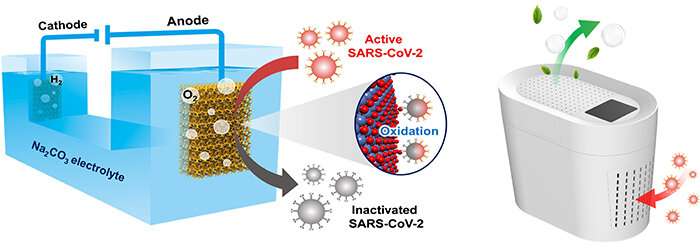
Coronavirus disease 2019 (COVID-19) caused by the severe acute respiratory syndrome coronavirus 2 (SARS-CoV-2) is spreading all over the world.
Designated hospitals, isolation places and cold-chain logistics may produce aerosols and wastewater containing SARS-CoV-2. Full disinfection of these aerosols and wastewater is important for blocking the spread of SARS-CoV-2.
Currently, sodium hypochlorite is the most popular disinfectant to kill SARS-CoV-2 in the environment. However, the extensive use of chlorine containing disinfectants causes serious pollution to the ecological system.
Recently, Prof. Deng Dehui’s group and Prof. Wang Fangjun’s group from the Dalian Institute of Chemical Physics (DICP) of the Chinese Academy of Sciences (CAS), in collaboration with Prof. Hu Yangbo from the Wuhan Institute of Virology of CAS, proposed a novel electrochemical oxidation strategy to inactivate SARS-CoV-2. The study was published in Science Bulletin on Dec. 30.
They used oxidative species generated on the anode in the water electrolysis, which achieved full inactivation of the SARS-CoV-2 in the laboratory.
“We developed a green and highly efficient electrochemical oxidation device to inactivate the SARS-CoV-2 based on the principle of redox reaction in water electrolysis,” said Prof. Deng. The electrochemical device employed in-situ formed nickel oxide hydroxide (NiOOH) as anode, Ni foam as cathode and sodium carbonate as electrolyte.
The researchers treated SARS-CoV-2 virus in the solution for five minutes at a voltage of five volts with the electrochemical device. They found that the virus was inactivated with a high efficiency of 99.99%.
Mechanism studies indicated that the reactive oxygen species generated on the NiOOH anode could effectively oxidize and damage the receptor binding domain of the SARS-CoV-2 spike glycoprotein, and thereby fully inactivated the virus.
Source: Read Full Article
